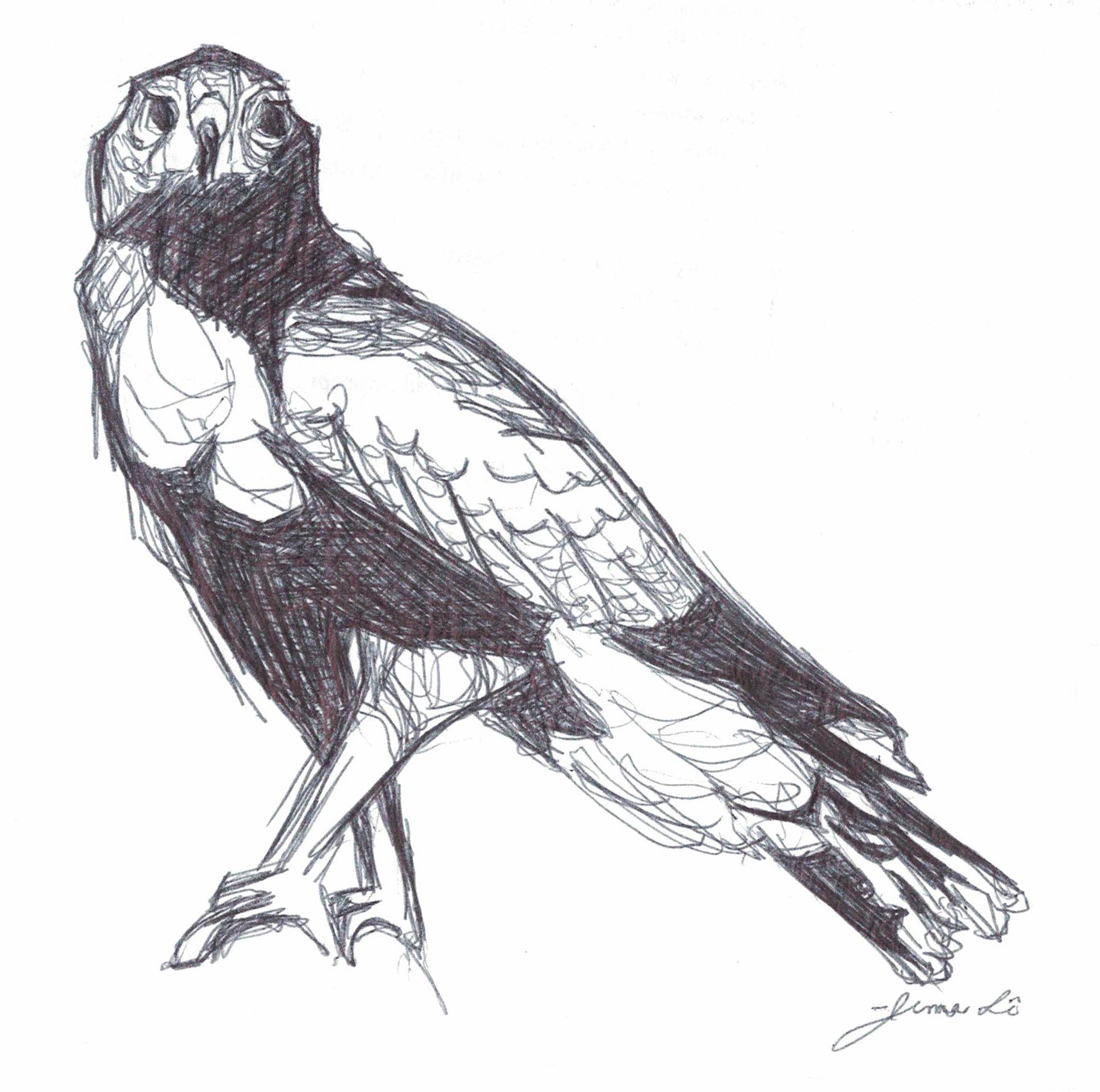Brandon Shimoda
San Xavier
San Xavier, born Francisco de Jasso y Azpilicueta in 16th-century Spain, was the first Jesuit missionary in Japan. He entered through Kagoshima, August 15, 1549, and proselytized for two years, with little success. A wooden effigy of San Xavier sleeps in a glass coffin in the San Xavier Mission on the Tohono O’odham reservation south of Tucson, Arizona.

Harris's Hawk
Ink drawing, 2018
The white cross on the hill of rocks
is a house without light
over the greenest fields in the valley
The virgin, embedded in rocks,
prepared the white cross
with the attributes of lightlessness
that illuminate subterranean life
where the cross enters earth
children lay flowers
the cross turns at night
into snakes
+
The wooden effigy of San Xavier
dreams, in his box, of Japan
Houses gleaming with ceramic carnations
fish
sun
mushroom foam on a river
the smell of salt
broths
socks
the fire-caller
grass butterflies animals
grazing insects beneath the rings of Saturn
old men
weaving shields for the funeral
dreams, in his effigial slumber, of the panorama
he conceives
to empty what sustains
No one listened
as he tried and failed
to articulate the word, the one
enfeebling supplication
+
Dirt-colored birds
fly circles
around
the cross
painted every so often
as a reminder
salvation
is a thick coat
that often stifles
spontaneous expression
+
I visited San Xavier today. He was sleeping,
surrounded by hundreds of people
in the rictus of their oblivion
marvels carved
in the dun-colored feathers
of solemn Incas
fashioned
as arbiters of justice
in mouth-like stratospheres
the knuckles of saints
and saints without feet
+
Religion is not the mold,
but people
who inject themselves into its sanctuaries
at the openings mold begins to foam,
across smaller, more verminous irises
florid spores become,
by virtue of being displaced,
thick plumes of confectionary smoke
rising off the sacrifices
of collective desperation
the brain cannot stop
reciting constellations
connecting the several incarnations of hell
where angels are arraigned, sent
spinning.
+
where the snake enters flowers
and rosaries
burn
The white cross
the impermeable mercy
 Brandon Shimoda's recent books include The Desert (The Song Cave, 2018) and an ancestral memoir called The Grave on the Wall (City Lights, 2019). He is currently writing (more often disintegrating) a book on the ongoing afterlife/ruins of Japanese American incarceration. He lives in the desert.
• Photo by Kelly Shimoda.
Brandon Shimoda's recent books include The Desert (The Song Cave, 2018) and an ancestral memoir called The Grave on the Wall (City Lights, 2019). He is currently writing (more often disintegrating) a book on the ongoing afterlife/ruins of Japanese American incarceration. He lives in the desert.
• Photo by Kelly Shimoda.
 Jenna Le is the author of Six Rivers (NYQ Books, 2011) and A History of the Cetacean American Diaspora (Indolent Books, 2018), which won second place in the Elgin Awards. She was selected by Marilyn Nelson as winner of Poetry by the Sea’s inaugural sonnet competition. Her poetry appears in Los Angeles Review, Massachusetts Review, and West Branch. Her visual art, including drawings and watercolors, has appeared or is forthcoming in Ad Libitum, Jubilat, and MAI.
• Photo by Minhha Nguyen.
Jenna Le is the author of Six Rivers (NYQ Books, 2011) and A History of the Cetacean American Diaspora (Indolent Books, 2018), which won second place in the Elgin Awards. She was selected by Marilyn Nelson as winner of Poetry by the Sea’s inaugural sonnet competition. Her poetry appears in Los Angeles Review, Massachusetts Review, and West Branch. Her visual art, including drawings and watercolors, has appeared or is forthcoming in Ad Libitum, Jubilat, and MAI.
• Photo by Minhha Nguyen.